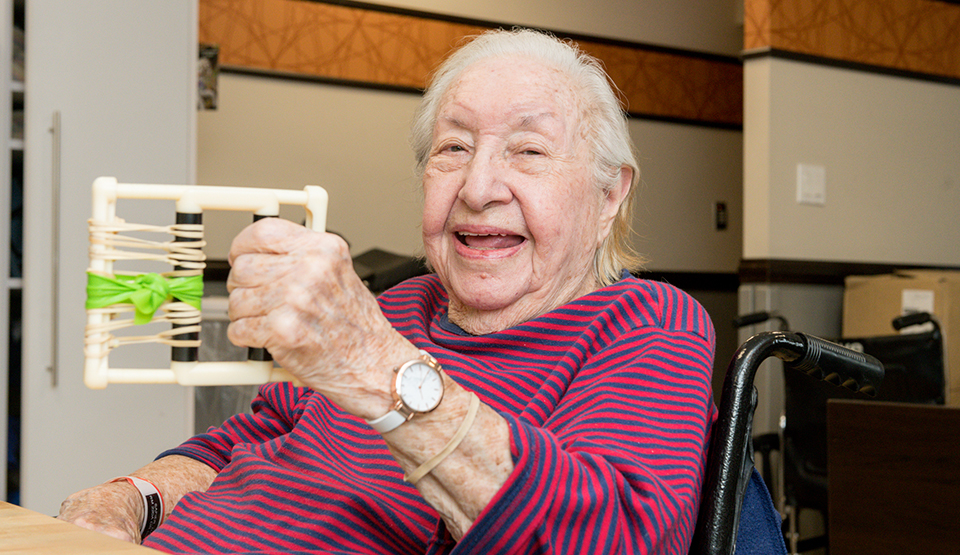Patient’s Age: 65-years-old
Admission Date: 10/19/2018
Admitted From: Winthrop University Hospital
Discharge Date: TBD
Length of Stay: TBD
Reason for Stay: Cerebellar stroke syndrome, hemiplegia and hemiparesis, and generalized muscle weakness.
How did patient hear about the Grand Pavilion: Hospital
Details of Experience:
Ms. Mildred Nixon was admitted to The Grand Pavilion from Winthrop University Hospital on October 19th, 2018. Ms. Nixon had experienced cerebellar stroke syndrome, hemiplegia, hemiparesis, and generalized muscle weakness. Upon arrival to The Grand Pavilion, Mildred was greeted by the nursing team and our concierge, Mark. She then went on to meet with our rehabilitation team, dietician, and social worker. The whole team was excited to get to know Mildred. Mildred is full of life and has a smile that lights up the room. She has an extremely optimistic attitude towards getting better and stronger.
Ms. Nixon arrived at The Grand Pavilion with the simple goal of rehabilitating and returning home safely. Ms. Nixon served as a registered nurse and worked in the medical field for 18 years. She has two devoted children and her greatest passion is her love for her nine beautiful grandchildren and three great-grandchildren. Ms. Nixon lives in Westbury, New York, in the home that she was brought up in. She enjoys her hobbies such as bingo, reading, and traveling.
It was Ms. Nixon’s first time joining us at The Grand Pavilion. She was hesitant when arriving at our subacute nursing community, but she knew that in order for her to get better and rehabilitate, it was in her best interest to receive the best rehabilitation and nursing care. Although Ms. Nixon did not participate much in activities, she mostly enjoyed her pleasant interactions with the nursing staff, rehabilitation staff, and fellow patients.
During her initial evaluation, Ms. Nixon was presented to the rehabilitation team with lower left extremity weakness, poor motor control, generalized muscle weakness, decreased activity tolerance, and an overall functional decline in her activities of daily living. She required maximum assistance to perform mobility tasks as well as when transferring to and from the bed.
At the time of her initial evaluation, Ms. Nixon was only walking 10 feet with maximum assistance using a rolling walker. It was the goal of physical therapy to increase her lower extremity range of motion, increase functional activity tolerance, and improve dynamic balance to allow for Ms. Nixon to return to her prior level of functional abilities.
Ms. Nixon was presented to the occupational therapy team with a decrease in endurance, activity tolerance, generalized weakness, right lower extremity pain when standing, and left upper extremity edema and weakness. The goal of occupational therapy was to develop and instruct on compensatory strategies, facilitate dynamic standing balance, and increase overall function with activities of daily living.
Ms. Nixon initially was presented to the rehabilitation team with a lot of pain bilaterally on her lower extremities. This made it difficult for her to participate with ambulation and with self-management, such as managing to go to the toilet independently. During her therapy progression, the therapist’s utilized electrical stimulation on her lower extremities, with emphasis on the inhibiting tibial and fibular nerve pain. With the combination of electrical stimulation and manual therapy, Ms. Nixon was in less pain and was able to participate in therapeutic activities and exercises.
Ms. Nixon participated in various therapeutic exercises on the mat such as heel slides, short and long arc quadriceps strengthening, and hip abductor strengthening activities. Ms. Nixon had made great improvement with her dynamic balance with neuro-muscular re-education activities; she was able to go from maximum assistance with transfer to supervision with sit to stand transfer after two months of therapy.
While currently being able to ambulate up to 150ft with a rolling walker with supervision, Ms. Nixon has also progressed with her activities of daily living. She is currently able to perform lower body dressing independently using adaptive devices such as a dressing stick and sock aid. Ms. Nixon has also made significant strength improvement on her left lower extremities, which initially was at a 1/5 strength grade at evaluation and currently is at 3/5 muscle strength grade.
When our Director of Concierge met with Mildred closer to her discharge date, she was full of appreciation towards the social workers that really worked long and hard overseeing her progress and keeping her informed with how things are coming along for her. She expressed her gratitude towards the nursing staff and rehabilitation staff who she felt always treated her with the utmost dignity and respect. Ms. Nixon also made a point to mention how much she appreciated the Administrator and the Concierge, always checking in on her and making sure that things were always in order. Here at The Grand Pavilion, we are proud and honored to provide Ms. Mildred Nixon with the excellent care she and all patients deserve.


